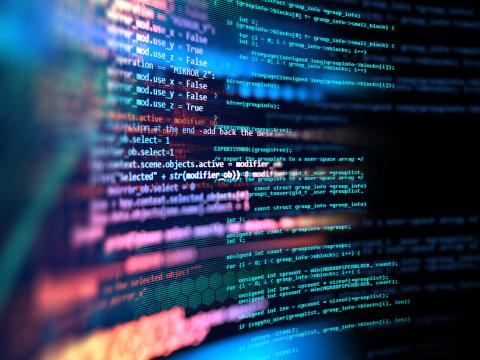DISA Calls on Industry to Build Transparency into Artificial Intelligence
Machine learning and artificial intelligence (AI) technologies can be used by DOD to gain a competitive advantage, especially in cyberspace operations. While the technology has made it easier for the military to operate and communicate, “It has also a unique set of challenges with dependencies and vulnerabilities for the department, our nation, our economy and our everyday lives,” said Vice Adm. Nancy Norton, USN, director of the Defense Information Systems Agency (DISA) and commander, Joint Force Headquarters–Department of Defense Information Network (JFHQ-DODIN). The admiral presented the keynote luncheon address at the AFCEA Rocky Mountain Cyberspace Symposium on February 5 and spoke to SIGNAL Magazine.
Adm. Norton also acknowledged that applying AI will require an increased level of comfort with automation, given the shift away from human-based processes it offers. Getting past the fear of trusting computer-based processes may be a challenge. "It is fear of doing something different,” she explained. “We tend to want to have a human in the loop all of the time so we know exactly what is happening and we can control it any point. But the reality is that introduces many more human errors and very definitely slows us down.”
In cyberspace, in defending the DODIN, the DOD receives 1.5 billion cyber events a day, and can’t respond manually to each one of these attacks. Automation and artificial intelligence are crucial to DOD’s cybersecurity. However, for the department to be successful and not introduce further risk, any solutions from the industry—related to cybersecurity or other applications—must be explicit.
VADM Nancy Norton, Director @USDISA and commander JFHQ-DODIN: There are 1.5 billion cyber events against the DODIN daily. AI and automation can play a key role. “We can’t process 1.5 events manually.” pic.twitter.com/fBOXLq86Py
— Kimberly Underwood (@Kunderwood_SGNL) February 5, 2019
“What we really need from industry is transparency and the understanding of what goes into the algorithms and making sure that we can build the confidence with our users and our administrators to know that it is not doing anything different than what we would want it to do, and that we would have the ability to recognize when something is going wrong and back it out and restart as necessary,” Adm. Norton stated.
The military’s use of machine learning, automation and AI is expanding across the department, she stated. “AI is changing our processes and systems, with procedures that traditionally required human intelligence and intervention to increase our productivity,” she said. “Automation will allow us to focus on other efforts pertinent to our nation and national defense.”
In June 2018, DOD Chief Information Officer (CIO) Dana Deasy’s office established the Joint Artificial Intelligence Center, known as JAIC, which will lead AI-related planning policy, oversight, ethics and safety within the department. Meanwhile, DISA created a team that determines how to apply such technologies to DISA’s existing portfolio. “The tools will target a variety of cybersecurity threats faced by cyber analysts within the agency and the department,” she said. “Our AI processes have to learn to think like a human and automatically correlate with threat intel and develop situational awareness tools and decision support tools to allow our warfighters to continue their mission even through a contested environment.”
And as noted, the DOD is incorporating artificial intelligence and automation into its cybersecurity tools. "This is critical because at the same time our adversaries are increasingly automating their cyber attacks,” Adm. Norton specified.
Outside traditional cyber operations, DISA is using AI applications to support warfighters in the effective and efficient use of the electromagnetic spectrum, the admiral noted. DISA also is using automation in accounting and financial processes.
In addition, DISA’s software-defined enterprise team is leading initiatives to use automation and orchestration to reduce the time needed to accomplish specific tasks, such as automating telecommunication circuit provisioning, reviewing and reducing risks of authorized service interruptions, or automating network configurations.
Together with the University of Southern California’s Institute for Creative Technologies, DISA’s knowledge management branch is developing a so-called knowledge management virtual human. In addition, DISA’s global service desk is working on another prototype called the DISA virtual assistant or DIVA, which will introduce AI into service desk processes, performing specific service desk functions, the admiral said.
For the DOD, artificial intelligence is not a new technology. “DOD has been investing in AI since the 1960s,” Adm. Norton stated. “What is new at this point is that the DOD is working to accelerate artificial intelligence-enabled capabilities to scale the impact of AI across DOD, beyond research and development for our joint force advantages.”
Unfortunately, industry priorities don’t necessarily align with the military’s when it comes to artificial intelligence, the admiral warns. “Industry naturally puts its focus is on what is going to deliver fast and earn profits,” she stated. “And that is not transparency and that is not cybersecurity. So we have to force it, and say if it requires you to slow down and it requires you to have more of a targeted market, then that it what you are going to have to do, because for us in DOD, we have to have that kind of transparency and cybersecurity."






Comments